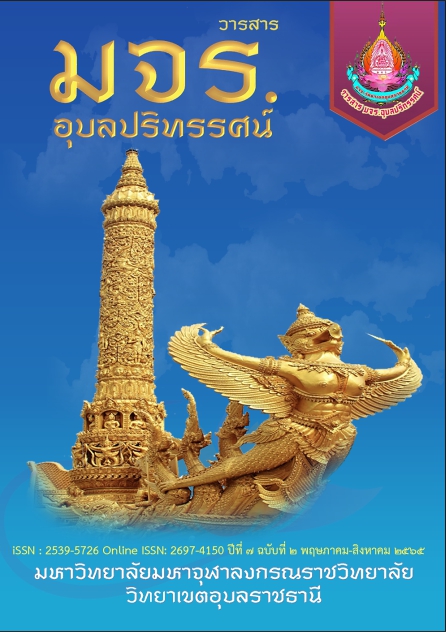MANAGEMENT OF BUDDHIST ECOLOGY WITH SYSTEMATIC INTEGRATION
Main Article Content
Abstract
This academic article presents a concept of the management of Buddhist ecology with systematic integration. A result of this study was found that ecology meant a system of relation among living things and non-living things in the same area with systematic relation, biological diversity and physical diversity. The ecology, according to its appearance, was divided into two types: natural appearance and creative appearance. If it was divided by means of conditions, it was divided into two types: biological ecology and physical ecology. This ecology, according to its elements, was divided into two elements: non-living elements and living elements. The non-living elements were non-organic matter, organic matter and physical surroundings. The living elements were a producer, a consumer, and decomposer. Ecological problems came from a natural process and human action both in the direct and indirect way. This made the ecology polluted and decadent. The management of systematic Buddhist ecology was the integrated management of relation and ecological types: the relation between human beings and societies, the relation between human beings and environment, the relation of belief, traditions, ceremonies and value, and a way of life and ecology. All of them were controlled with the social rules: law and morality. The social environment specified the characteristics of members' lives in each society. Here, the members were a part of societies in a way that they had the wanted characteristics in the same social environment of the ecology by means of the integrated Buddhist principles for the ecological management:
Article Details
References
กลุ่มเสขิยธรรม. (2535). พระกับป่าไม้ความจริงที่หายไป. กรุงเทพฯ : เม็ดทราย,
เกษม จันทร์แก้ว. (2545). การจัดการสิ่งแวดล้อมแบบผสมผสาน. กรุงเทพฯ : มหาวิทยาลัย
เกษตรศาสตร์,
ณรงค์ เส็งประชา. (2541). มนุษย์กับสังคม. กรุงเทพฯ : โอเดียนสโตร์,
เทพพร มังธานี, (2548).“การวิเคราะห์พุทธจริยศาสตร์เถรวาทในมหาสุบินชาดก”,
บัณฑิตวิทยาลัย : มหาวิทยาลัยมหิดล,
ดอกรัก มารอด. (2555). นิเวศวิทยาป่าไม้. กรุงเทพฯ : พิมพ์ที่มหาวิทยาลัยเกษตรศาสตร์,
ประพันธ์ ศุภษร. (2542). พระวินัยกับการอนุรักษ์สิ่งแวดล้อม. กรุงเทพฯ : มหาวิทยาลัย
มหาจุฬาลงกรณราชวิทยาลัย,
สมเด็จพระพุทธโฆษาจารย์ (ประยุทธ์ ปยุตฺโต). (2548). การพัฒนาที่ยังยืน. พิมพ์ครั้งที่ 82.
กรุงเทพฯ : มูลนิธิโกมลคีมทอง,
พระอินถนอม ศรีหาตา. (2557). “การสังเคราะห์กระบวนการการจัดการระบบนิเวศเพื่อ
การอนุรักษ์ป่าและสัตว์ป่าในภาคอีสาน”.บัณฑิตวิทยาลัย:มหาวิทยาลัยมหาสารคาม
ประยูร วงศ์จันทรา. (2553). วิทยาการสิ่งแวดล้อม. บัณฑิตวิทยาลัย : สำนักพิมพ์
มหาวิทยาลัยมหาสารคาม,
มหาวิทยาลัยมหาจุฬาลงกรณราชวิทยาลัย. (2539). พระไตรปิฎกภาษาไทยฉบับมหาจุฬาลงกรณราชวิทยาลัย.กรุงเทพฯ : โรงพิมพ์มหาจุฬาลงกรณราชวิทยาลัย,
ราชบัณฑิตยสถาน. (2546). พจนานุกรมฉบับราชบัณฑิตยสถาน พ.ศ. 2542. กรุงเทพฯ :
นานมีบุ๊คส์พับลิเคชั่นส์,
สำนักงานคณะกรรมการพัฒนาเศรษฐกิจและสังคมแห่งชาติ, แผนพัฒนาเศรษฐกิจและสังคม
แห่งชาติฉบับที่ ฉบับที่ 12 พ.ศ.2559-2564.
Harper R., (2002). The Measurement of Social in The United Kingdom. London
: Office for National Statistics,

